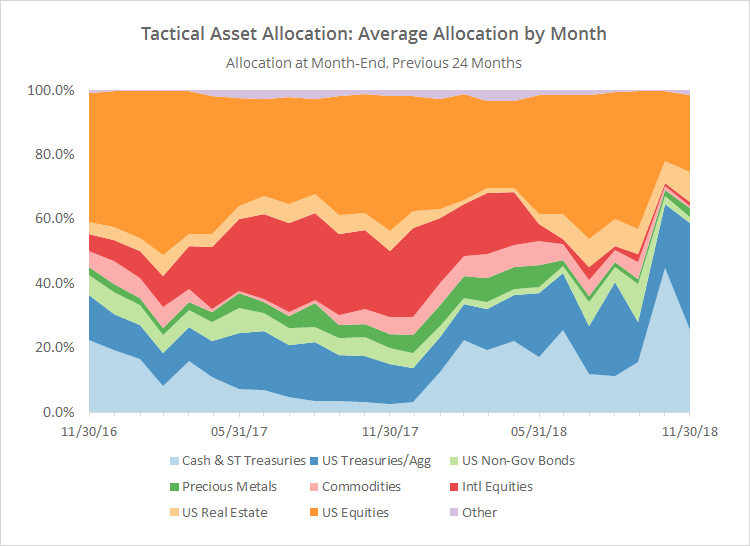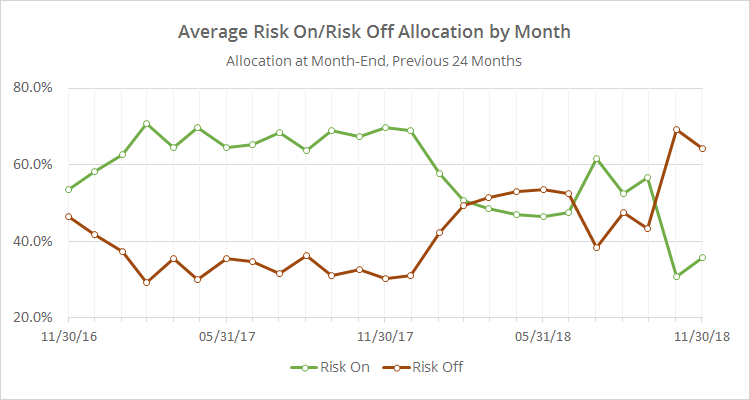This is a summary of the recent performance of a wide range of excellent tactical asset allocation strategies, net of transaction costs. These strategies are sourced from books, academic papers, and other publications. While we don’t (yet) include every published TAA model, these strategies are broadly representative of the TAA space. Learn more about what we do or let AllocateSmartly help you follow these strategies in near real-time.
Commentary:
 TAA entered November positioned defensively, with a large allocation to cash and US Treasuries (read more). That defensive bet paid off right up until the late month market rebound. In the end, most strategies had too little exposure to risk assets to keep pace with the 60/40 benchmark for the month.
TAA entered November positioned defensively, with a large allocation to cash and US Treasuries (read more). That defensive bet paid off right up until the late month market rebound. In the end, most strategies had too little exposure to risk assets to keep pace with the 60/40 benchmark for the month.
Despite the strong showing in November from many risk assets, TAA is continuing to maintain that defensive posture (see data dump below).
Last month’s comments still remain true: This is a real hero-or-zero moment for TAA. If this rebound continues into December, TAA is going to be left too defensive and trailing the recovery. If the market turns weak again, TAA is going to be well positioned to weather the storm.
Data Dump:
With such a large pool of published strategies to draw on (45 and counting), we’re able to draw some broad conclusions about the state of TAA. The following two charts help to show trends in the asset classes that TAA as a whole is allocating to over time.
The first chart shows the average month-end allocation to categories of assets by all of the strategies that we track. For example, “US Equities” may include everything from the S&P 500 to individual stock market sectors. Defensive assets tend to be at the bottom of the chart, and offensive at the top. The data on the far right of the chart reflects where TAA stood as of the end of the most recent month.
The biggest shift for the month was between defensive assets: out of cash (from 45% to 26%) and into US Treasuries (from 20% to 33%). Remaining allocation to anything other than US equities and real estate remains close to nil.
In the second chart below, we’ve combined average TAA allocation into even broader categories: “risk on” (equities, real estate and high yield bonds) versus “risk off” (everything else). We realize that some asset classes don’t fit neatly into these buckets, but it makes for a useful high level view.
Note the continued high exposure to defensive assets. A little perspective however: we’re a long way from historical highs (click for a longer view). We were at a much higher level of defensive exposure as recently as early-2016. It didn’t work out that time as the market quickly recovered (see previous “hero-or-zero” comments), but that won’t necessarily be the case this time. TAA tends to be more about controlling losses, as opposed to chasing big returns, so it’s unsurprising that TAA has reacted so cautiously to recent market weakness.
We invite you to become a member for about a $1 a day, or take our platform for a test drive with a free limited membership. Put the industry’s best tactical asset allocation strategies to the test, combine them into your own custom portfolio, and then track them in near real-time. Have questions? Learn more about what we do, check out our FAQs or contact us.

